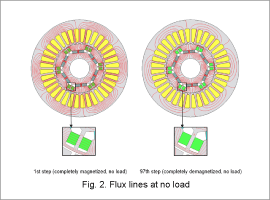*Please prepare a license ID and password for the license administrator.
*It is different from the service for JMAG WEB MEMBER (free membership). Please be careful.
Overview

There are many kinds of variable flux motors, but the kind that makes a permanent magnet magnetization variable is called a memory motor.
The magnetic field for magnetizing and demagnetizing memory motor magnets is generated by the same three-phase coil current as in the drive system, so the magnetic force can be changed without adding any special devices.
In this document, the change in motor characteristics is checked as the memory motor variable magnet magnetization is changed using the three-phase coil current. One example of modeling a variable magnet is presented as well.
The magnetic field for magnetizing and demagnetizing memory motor magnets is generated by the same three-phase coil current as in the drive system, so the magnetic force can be changed without adding any special devices.
In this document, the change in motor characteristics is checked as the memory motor variable magnet magnetization is changed using the three-phase coil current. One example of modeling a variable magnet is presented as well.
Changes in Variable Magnet Magnetization State and Induced Voltage
Fig. 1 shows the induced voltage when the variable magnets are fully magnetized, then demagnetized, and then magnetized again.
In Table 1, the induced voltage state for each interval in Fig. 1 is shown as well.
In interval (3) in Fig. 1, from demagnetizing the variable magnets, only the induced voltage due to the fixed flux magnets can be seen. The maximum change of induced voltage from this model is approximately 50 %.


Flux Line Changes Under No Load

Fig. 2 shows the flux lines under no load when the variable magnets are magnetized and demagnetized.
The left is when magnetized and the right is when demagnetized. When the variable magnets are demagnetized, the magnetic flux from the magnets flowing in the stator decreases.
In the enlarged view of the two fully magnetized variable magnets on the left, several flux lines penetrate the variable magnets. The magnetic flux produced by the variable magnets passes through the core gap before returning to the variable magnet.
On the other hand, in the right view for the demagnetization state, the flux lines do not penetrate the variable magnets, and the flux lines generated from the fixed magnetic force magnets flow around the variable magnets. This means that a stronger magnetic flux is generated from the fixed magnetic force magnets than from the variable magnets.
The left is when magnetized and the right is when demagnetized. When the variable magnets are demagnetized, the magnetic flux from the magnets flowing in the stator decreases.
In the enlarged view of the two fully magnetized variable magnets on the left, several flux lines penetrate the variable magnets. The magnetic flux produced by the variable magnets passes through the core gap before returning to the variable magnet.
On the other hand, in the right view for the demagnetization state, the flux lines do not penetrate the variable magnets, and the flux lines generated from the fixed magnetic force magnets flow around the variable magnets. This means that a stronger magnetic flux is generated from the fixed magnetic force magnets than from the variable magnets.
Variable Magnet Operating Points

The variable magnet operating points are shown in Fig. 3. While changing the input magnetization characteristics, the residual magnetic flux density Br changes when a magnetization/demagnetization current is applied.


